The Medical Research Council’s new chromosome-shaped lab in Cambridge is an example of how attention to detail and planning can deliver complex buildings on time and to budget
As we exit the construction site, Jim Power pauses briefly, then says: “I want to show you something.” He takes me to a large trough with flexible hoses fixed at regular intervals around the perimeter. He explains that the hoses squirt compressed air that workers use to blow the mud off their boots before going into the canteen. “I made it myself,” he says proudly. “It means workers don’t drag mud into the canteen.”
This attention to detail extends throughout the whole of Power’s domain. He is the construction manager for Bam, which has the contract to build the Laboratory of Molecular Biology (LMB) in Cambridge, commissioned by the Medical Research Council (MRC).
A heavy responsibility rests on Power’s shoulders, as client project director David Julian explains: “Quality was even more important than usual as the laboratory is the MRC’s flagship facility. Fourteen Nobel prize winners have come out of LMB and we want to continue that tradition and provide the right environment for them to do it.” Julian also wanted a lab that would be good for 100 years - a long time for such a technical building.
Inevitably, the MRC also wanted value for money and timely delivery. So a huge amount of planning went into ensuring that the building was one that would attract top scientists from around the world. A new building was needed because the old lab could not be upgraded any longer. Laboratories require high air change rates, and humidity and temperature levels must be closely controlled by plant that does not produce too much noise or vibration. And as standards become more stringent, services need more space - according to Julian they should be upgraded every 15 years. The old LMB building simply ran out of room for this expansion.
The services strategy for the new building was so important that Julian tackled it before the architectural concept was arrived at. Appropriately for a top scientific institution, research was the key to finding a solution. The answer was found in a building in San Diego called the Salk Institute. “Our existing lab was built at the same time as the Salk Institute, which is still going strong,” says Julian. “Ours doesn’t have the capacity to extend the services. If we got a building like the Salk Institute, it could last 100 years.”
The solution is interstitial service floors.
For every floor at the Salk Institute there is a dedicated services floor. The new LMB building is six storeys high, but only has three floors of labs. All the services run horizontally through this space and drop into the labs where needed. “This means we can work on the services with the minimum of disruption to the scientists in the building,” says Julian. “It also means we can update the services without having to decant scientists somewhere else.”
Doesn’t this make the building rather expensive? Not according to Julian. The services make up 60% of the value of the project and the shell and core 40% - in most buildings these proportions are reversed. The interstitial floor structure has also been installed economically. “When you start to look at the cost of the structure it’s quite a small amount,” says Julian.
According to BAM the interstitial floors added 10% to the cost of the job. Julian adds that the MRC saved £1m on another lab project by squeezing plant and riser space but found the scheme ended up costing an extra £2m. “What appeared initially to be a saving actually resulted in an increased cost as you had to fit the plant into a smaller space, which meant it had to be miniaturised,” says Julian. “It was also less efficient and cost more to run.”
Other issues that needed resolving were vibration and electromagnetic fields. “All our other buildings have problems with vibration and electric fields that interferes with the science,” says Julian. The solution was to build a separate energy centre containing the chillers, transformers and back-up generators linked to the main building by two underground tunnels. There were also four big plant towers next to the building with three huge air handling units in each.
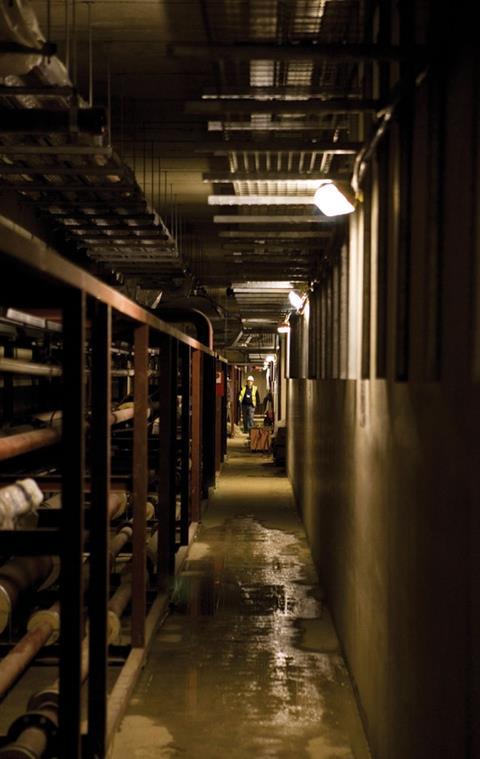
Another source of noise and vibration is the Cambridge-to-London railway line, which runs right past the laboratory. This has been resolved by using a heavy concrete frame and locating vibration-sensitive activities in the building.
With a carefully worked up design in place it was time to look at delivery. The project was a £200m, design-and-build job with a 148-week programme. Unfortunately, that price was £26m over the MRC’s budget so savings had to be found. Some of them were achieved by giving the kitchen fitout to an external catering company. Another idea was to specify 45% relative humidity in the building rather than 55%, which meant less humidification plant.
Then everything from door handles to lighting was examined and cheaper items were specified where possible, but the biggest saving was on the facade. This was a triple skin system, specified to keep the building cool in the summer. The original design had a 700m gap between the inner and outer skins and was installed as two separate components. Some £6m has been saved by sourcing a system from Swiss company Fahrni, which functions in the same way as the original but has a 200mm gap and comes as one unitised facade, which is much easier to install.
A second plank in this carefully worked up strategy was to tolerate as few variations as possible. Complex, bespoke jobs involving many stakeholders tend to suffer from a lot of client mind changing as the job progresses. Julian and Power knew this could wreck their cost and programme goals. “Interrupting the process is too disruptive,” says Power. “It’s much easier to retrofit at the end.” Julian says he gets stakeholders to sign off designs at each stage. He also draws up a statement to make it explicit exactly what is being signed off, as not everyone can understand a technical drawing. “In some of my projects there haven’t been any changes at all because of the sign-off regime,” says Julian proudly. But variations are not completely banned on this job - there is a filtering process that will allow crucial changes to get through.
Power’s contribution is to deliver the building as efficiently as possible. Much of it was designed using 3D, which was the first time some of the consultants, including Adams Kara Taylor, had used it. The services are fully designed and co-ordinated, including their dimensions. Clash detection was used to minimise delays and extra costs on site. Each specialist contractor gets the part of this drawing relevant to its trade and works from it. According to Power this has worked well. “I guess we wouldn’t get into double figures for clashes on each floor and those are isolated and minor in nature,” he says. “Given the complexity of the services that’s pretty good.”
Bam devised an original way of getting ductwork, cables and pipes from the interstitial floors into the labs. According to Power there were “thousands” of penetrations on this job, which could have been immensely time consuming to create through the concrete floors. Instead, a 650mm-wide void running the length of the building was left in the floor. Bam had a 170mm-thick panel consists of foam insulation sandwiched between two sheets of plywood made specially for the job. Drilling holes through this is relatively easy and the panels can also be replaced, so it is easier to reconfigure the services later if needed.
The second tool in the efficiency box was prefabrication. “It’s a great benefit in terms of programme certainty, quality and health and safety,” says Power. Most of the services are prefabricated. For example, the vertical risers came as complete modules and were dropped into position and bolted together. “These are the result of a lot of careful planning and design,” says Power. “Bolting it together on site is the easy bit.”
The pipes connecting the energy centre to the building were done in the same way. Big components including the air-handling units and generators came as component parts and were bolted together on site.
Power also went to considerable lengths to make sure there were no delays during the job. For example, two specialists were selected for critical packages, including ductwork and pipework, in case one went bust. Bam also carried out careful due diligence on its suppliers to make sure none were likely to go into administration.
A concrete batching plant, used for the frame construction, also guaranteed a secure supply of concrete and helped keep the job moving during last winter’s cold weather. According to Power it was too cold to pour concrete for a whole month, but he managed to keep some work going anyway. “We introduced a boiler to heat the concrete, which worked for smaller elements that you could wrap up so the concrete temperature didn’t drop below five degrees,” he says. The batching plant also cut out some 10,000 lorry movements through the neighbouring hospital access road.
Power has got the building watertight in some areas and the fitout is under way. The cladding has been fixed to most of the building, apart from the plant room towers. These are waiting for the air handling units to be delivered and the big items of plant are yet to be fitted to the energy centre.
There is still a huge amount of work to do inside the building before LMB scientists can move into their new home between spring and summer 2012, but at least Power will be able to pack away his boot cleaning machine long before.
The X Factor
Given its pioneering work on DNA it’s no great surprise the lab is shaped like an X chromosome in plan. The Medical Research Council wanted the laboratories to be sandwiched between an area for writing up experiments running along the perimeter of the building and technical support and equipment spaces.
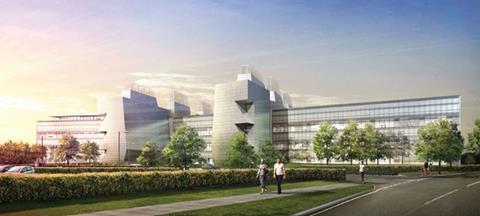
Architect RMJM organised the social and administration spaces around this arrangement. There is a big atrium in the centre of the building and this includes a lecture theatre spanning the atrium at first floor level. There are also seminar rooms spanning the atrium located towards its centre where the arms of the X meet, and places to get a cup of coffee. One element that the MRC wanted to recreate from their last building was the top floor restaurant with views over the surrounding countryside.

RMJM international principal Colin Moses saw the MRC’s desire to locate as much as the plant as possible away from the building as an opportunity. The four big towers housing the air handling units will be clad in stainless steel shingles to give the building a distinct identity. “Normally in a building like this you hide the plant on the roof where you don’t see it,” he says. “Here it’s become one of the strongest visual elements in the building.”
All shook up
Vibration is bad news in laboratories because it can interfere with delicate experiments. It was particularly bad news here because this laboratory is right next to a railway line. “Passenger trains aren’t too bad, it’s the freight trains which are the problem, particularly the end of the site next to the railway line,” explains John Risley, project engineer for Adams Kara Taylor. He says the design brief set down very tight limits for vibrations levels within the labs. “Structurally we could easily meet those criteria, but not economically.”
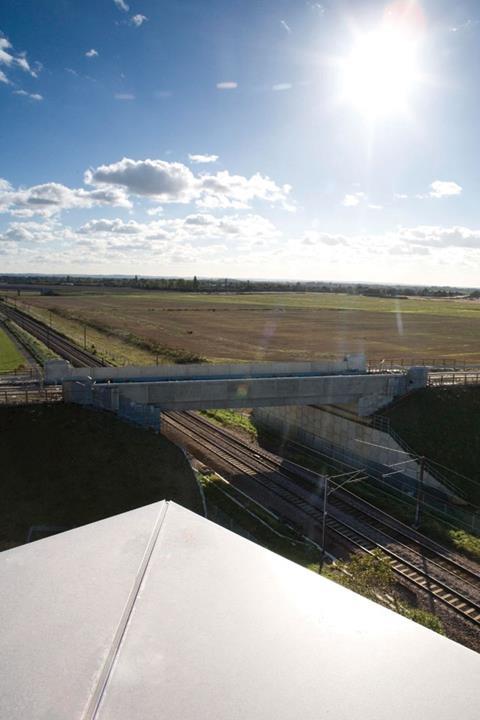
Risley says the solution was to talk to the scientists to find out exactly what they needed so a cost-effective compromise could be found. The ground floor has the best vibration performance as the span between the piles is relatively short, which makes for a more rigid slab. All sensitive equipment, including electron microscopes, has been located here with the most sensitive located at the end of the building furthest from the railway line. Where sensitive equipment is needed in vibration-prone areas, air tables that damp out vibration have been installed.
According to Risley, a concrete frame was the obvious solution for the upper floors as its greater mass helps damp out vibration. Surprisingly he says the 425mm deep slabs used are barely thicker than on a standard building due to the big spans between columns. Again, air tables are used in sensitive areas. Keeping all the plant outside the building also helps cut vibration levels.
The floor to slab height is 6m in this building because of the interstitial floors. These are suspended from the slab above, with steelwork sitting on the floor providing some additional support. All the services are suspended from the slab above. This means the interstitial floors feature relatively thin 150mm concrete floors on steel decking and can only take the weight of maintenance personnel. This is one area where Power had to scrap prefabrication in favour of conventionally assembled services as the floors couldn’t support the weight of prefabricated modules.





















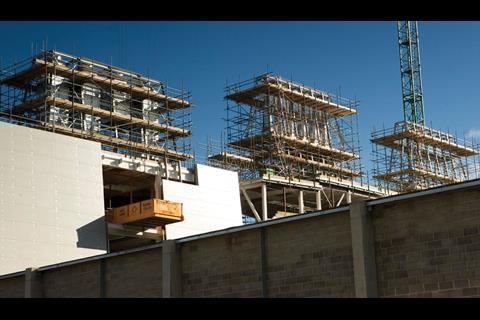
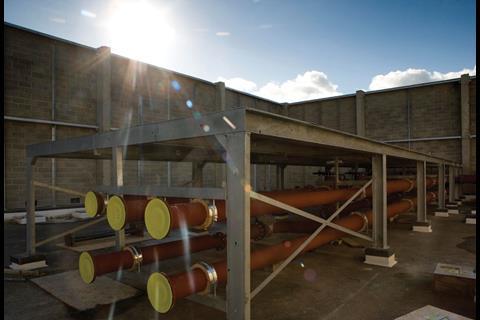
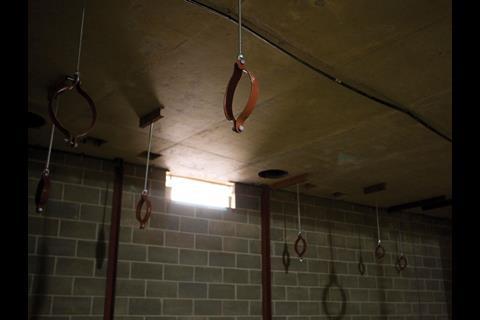
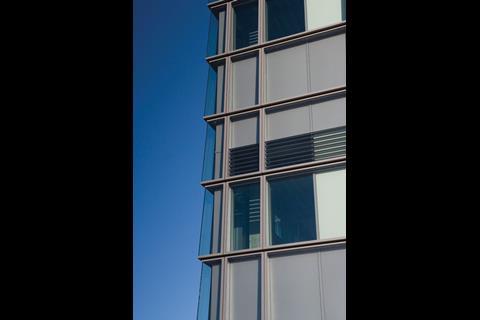
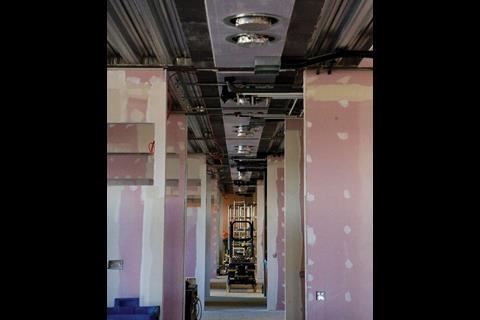
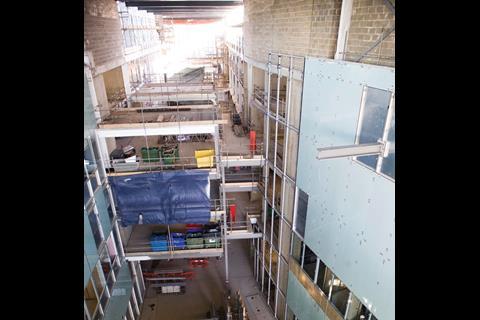







No comments yet